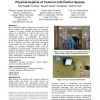Free Online Productivity Tools
i2Speak
i2Symbol
i2OCR
iTex2Img
iWeb2Print
iWeb2Shot
i2Type
iPdf2Split
iPdf2Merge
i2Bopomofo
i2Arabic
i2Style
i2Image
i2PDF
iLatex2Rtf
Sci2ools
CHI
2010
ACM
2010
ACM
Supporting coordination in surgical suites: physical aspects of common information spaces
To accommodate frequent emergencies, interruptions, and delays, hospital staff continually make and coordinate changes to the surgery schedule. The technical and social aspects of coordination in surgical suites have been described by prior studies. This paper addresses an understudied aspect of coordination: the physical environment. Based on a field study of four surgical suites in two large academic centers, we show how the physical layout of hallways and rooms, and barriers and spaces around displays and key coordinators, support or fail to support the common information spaces used for coordination. We use the concept "information hotspots" to represent how physical places and their characteristics facilitate coordination. We developed design principles based on the concept of information hotspots that should guide architectural considerations for coordination in dynamic environments such as hospitals. Author Keywords Coordination; physical environment; shared displays;...
CHI 2010 | Human Computer Interaction | Information Hotspots | Physical Environment | Surgical Suites |
| Added | 10 Feb 2011 |
| Updated | 10 Feb 2011 |
| Type | Journal |
| Year | 2010 |
| Where | CHI |
| Authors | Peter Scupelli, Yan Xiao, Susan R. Fussell, Sara B. Kiesler, Mark D. Gross |
Comments (0)

